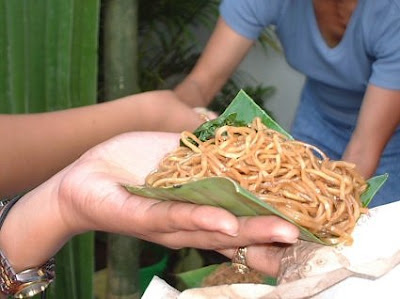
It's time for Pahiyas Festival back in my hometown. The festival is celebrated in the town of Lucban, Quezon every 15th of May. This is done in honor of San Isidro Labrador, the patron saint of our town. This tradition started during the 16th century as a way of giving thanks for a good harvest to assure farmers of more bountiful harvests in forthcoming seasons.
For friday five, i want to share the top five colorful things during Pahiyas festival.
Kiping is a brightly-colored, leaf-shaped wafer made of rice paste and used as decoration. The preparation of kiping starts with the collection of mature leaves which will serve as molds. Leaves like kabal, kape, talisay (umbrella tree), kakaw (cocoa), antipolo and banana (saba). Mature leaves are used in order to be able to use them three times or more.

Laon rice is used in the production of kiping to prevent unnecessary cracking of the rice wafer. The rice is soaked for two hours, then ground with water until it turns pasty. For every ganta of rice, at least three packets of food coloring and about 1/2 teaspoon of rock salt is used.
The rice paste is spread on each leaf and steamed for at least 30 minutes. After steaming, each leaf is dried until ready for peeling. After peeling them off the leaves, the kipings are piled on top of each other and compressed by placing a weight on top for half a day.
I still remember when we were small, we had that "summer job": peeling off kiping for .05 cents a leaf. we were sitted in circles and making our best bets who's gonna have the most numbered of leaves peeled. it's not easy to perfectly peel the kiping. you have to peel off slowly and carefully, otherwise the kiping will be torn off and becomes useless.

After the festival, the kipings are processed to become chips, sometimes cooked grilled or fried. i prefer grilled though. traditionally, from the past, after the parade, kipings were given or thrown to groups of people as free treats. But, with this global crisis now, i guess the "free treats" are set aside. Kiping costs too much.
Anok is a term used in Lucban for miniature dummy, a mannequin that depicts a farmer. It is displayed during the Pahiyas, complete with a farmers outfit and complimented with farm tools such as bolo and salakot. The creativity of Lucbanins are evident with the way the anok is presented. Some are animated and in fact live persons act as anok to the delight and surprise of onlookers, as the anok moves.
During pahiyas, a lot of higante (giant mascots) roam thru the streets to make the parade alive. Small kids were their best "targets" because kids are often scared. higantes have their way of bowing in front of the kids and running after them. when we were young, we used to sing, "higanteng putol, nanghahabol..."
Longganisang Lucban - One of the delicacy of our town is Longganisang Lucban. It is a native sausage that tastes uniquely compared to other native sausages in other provinces.
here's the simple recipe:
Ingredients:
1 kg of cubed (as opposed to chopped or ground) pork with fat.
¼ cup of oregano extract (can be more or less depending on taste)
1 teaspoon of paprika
1 teaspoon of salt
1 cup of chopped garlic (acts as the preservative)
Sausage casing (pork intestines preferred)
Directions:
1. Get a pan place the sausages in it and add water till the sausages are half covered.
2. Boil the sausages and prick them so that the casings won’t explode.
3. Cook till the water is all evaporated and what remains is the oil from the sausage.

whenever i go home, it's always a must for me to bring longganisa back here in italy. smells and tastes good.
Pancit Habhab - This local delicacy of Lucban is sauteed miki noodles with pork meat, pork liver and shrimp. pechay and sayote is a must vegetable ingredient. what makes this dish unique is the way it is eaten. it is placed in a banana leaf and eaten straight to your mouth without using any utensil. pancit hab-hab is drizzled with vinegar to enhance its taste.
Cow parade is also the main feature in the pahiyas procession. cows having their shows (they can basically kneel down). it's always a wonder to see these carabaos dressed up and artfully decorated too, bagging the "best carabao" competition.

Beautiful lads and handsome lasses also put their best unique gowns and suits during the parade. the dresses were made from native products of lucban, like buli or buntal, to mention some. i give the designers two thumbs up. Bravi!
Other colorful sights were the beautiful buntal hats decorated and sold as souvenirs by the tourists.
well, i sure miss again the hell of fun back home. i'm sighing here for 16 years! i always dream to be home for this event.
should i make a plan next year?












No comments:
Post a Comment